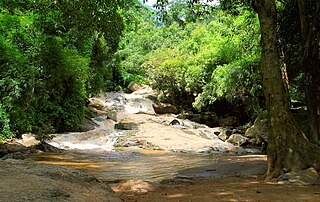
Dombeya is a flowering plant genus. Traditionally included in the family Sterculiaceae, it is included in the expanded Malvaceae in the APG and most subsequent systematics. These plants are known by a number of vernacular names which sometimes, misleadingly, allude to the superficial similarity of flowering Dombeya to pears or hydrangeas. Therefore, the genus as a whole is often simply called dombeyas. The generic name commemorates Joseph Dombey (1742–1794), a French botanist and explorer in South America, involved in the notorious "Dombey affair", embroiling scientists and governments of France, Spain, and Britain for more than two years.

Neea is a genius of plants in family Nyctaginaceae from the Caribbean region, Central and South America. Members of the genus are commonly called Nia, Neea, or saltwood. The genus was named by botanists José Pavón and Hipólito Ruiz in honor of Luis Née, a botanist on the Malaspina Expedition.
Neea amplexicaulis is a species of plant in the Nyctaginaceae family. It is endemic to Panama. It is threatened by habitat loss.
Neea darienensis is a species of plant in the Nyctaginaceae family. It is endemic to Panama. It is threatened by habitat loss.
Neea ekmanii is a species of plant in the Nyctaginaceae family. It is endemic to Cuba. It is threatened by habitat loss.

Shorea acuminatissima is a species of plant in the family Dipterocarpaceae. It is endemic to Borneo. It is threatened by habitat loss.
Henrik [Heinrich] Franz Alexander Baron von Eggers, was a Danish professional soldier and botanist.
Castanopsis acuminatissima is an evergreen tree native to Southeast Asia and New Guinea. It is known by a variety of common names over its range, including white oak, New Guinea oak, Papua New Guinea oak, ki riung, ko-duai, ko-soi, ko-mat, meranak, and riung anak.

Prothysana felderi is a moth in the family Bombycidae, whose larvae are known as shag-carpet caterpillars. It is found from Mexico, south to Panama and into South America, at least to Ecuador.

Cranichis is a genus of flowering plants from the orchid family, Orchidaceae. It contains about 50 species, native to South America, Central America, Mexico and the West Indies, with one species (C. muscosa) extending into Florida.

Euphronia is a genus of three species of shrubs native to northern South America and is the only genus in the family Euphroniaceae. It was previously classified in the Vochysiaceae family and elsewhere due to its unique floral features, but the APG III system of 2009 recognized Euphroniaceae as distinct and placed Euphronia in it. Based on molecular data from the rbcL gene, it is sister to the Chrysobalanaceae.
The Northwest Energy Efficiency Alliance (NEEA) is a non-profit organization working to accelerate energy efficiency in the Pacific Northwest through the acceleration and adoption of energy-efficient products, services and practices. NEEA is supported by and works in partnership with more than 140 Northwest utilities, the Bonneville Power Administration and Energy Trust of Oregon. NEEA's efforts serve Idaho, Montana, Oregon and Washington.

Doi Suthep–Pui National Park is a national park in Chiang Mai Province in Thailand. It includes Wat Phra That Doi Suthep, a Buddhist temple, and Bhubing Palace, the winter residence of King Bhumibol Adulyadej and family. The park is a protected area for flora, fauna, and habitat.
N. floribunda may refer to:
Prothysana terminalis is a moth in the family Bombycidae, whose larvae are known as shag-carpet caterpillars. The species was first described by Francis Walker in 1855. It is found in South America.
The National Education Examinations Authority (NEEA) is an agency of the Chinese Ministry of Education, headquartered in the Li Ye building (立业大厦), Tsinghua Science Park, Haidian District, Beijing. It administers public certificate tests and tests of foreign origin in Mainland China, including those for adults and prospective university students.
Fegimanra is a small genus of trees in the subfamily Anacardioideae of the cashew and sumac family Anacardiaceae. They grow naturally in west and west-central tropical Africa.
Self-Taught Higher Education Examinations (STHEE) is a test for graduation of higher education and bachelor's degree in China. STHEE allows students to finish studies through self-study without going to school. It is practiced by National Education Examinations Authority(NEEA) of China. NEEA is an agency of the Chinese Ministry of Education.
Nea and Neea are Finnish female given names.
Schefflera acuminatissima is a flowering plant in the family Araliaceae. it is endemic the Philippines.







